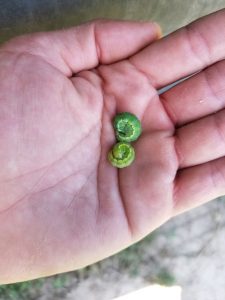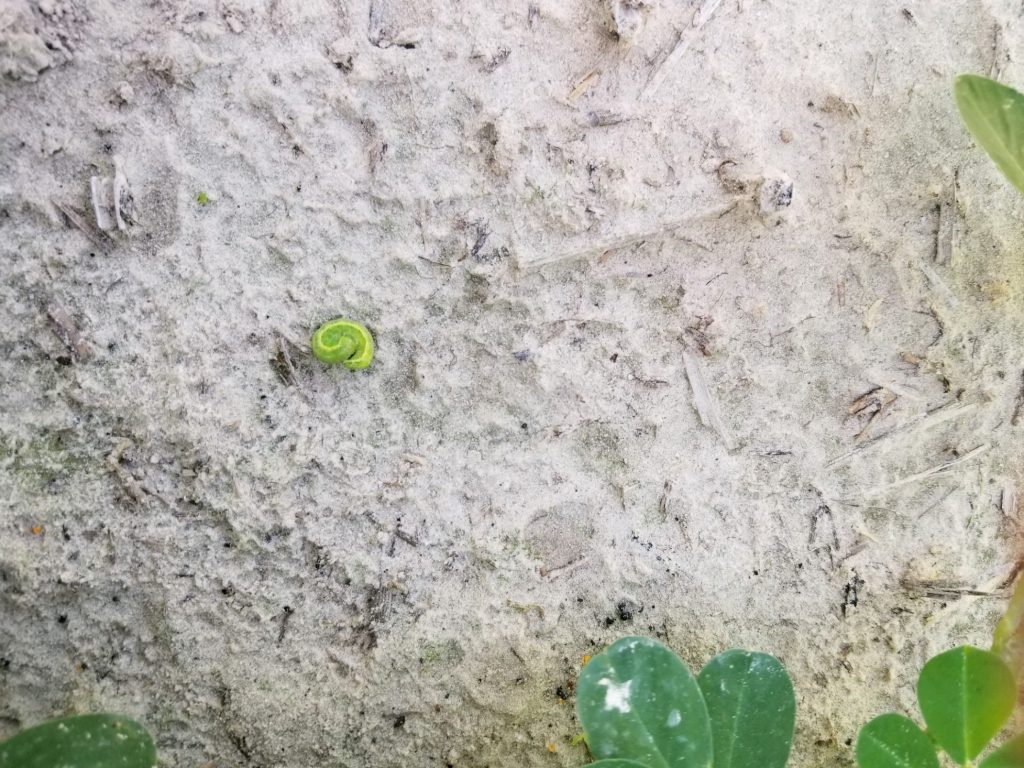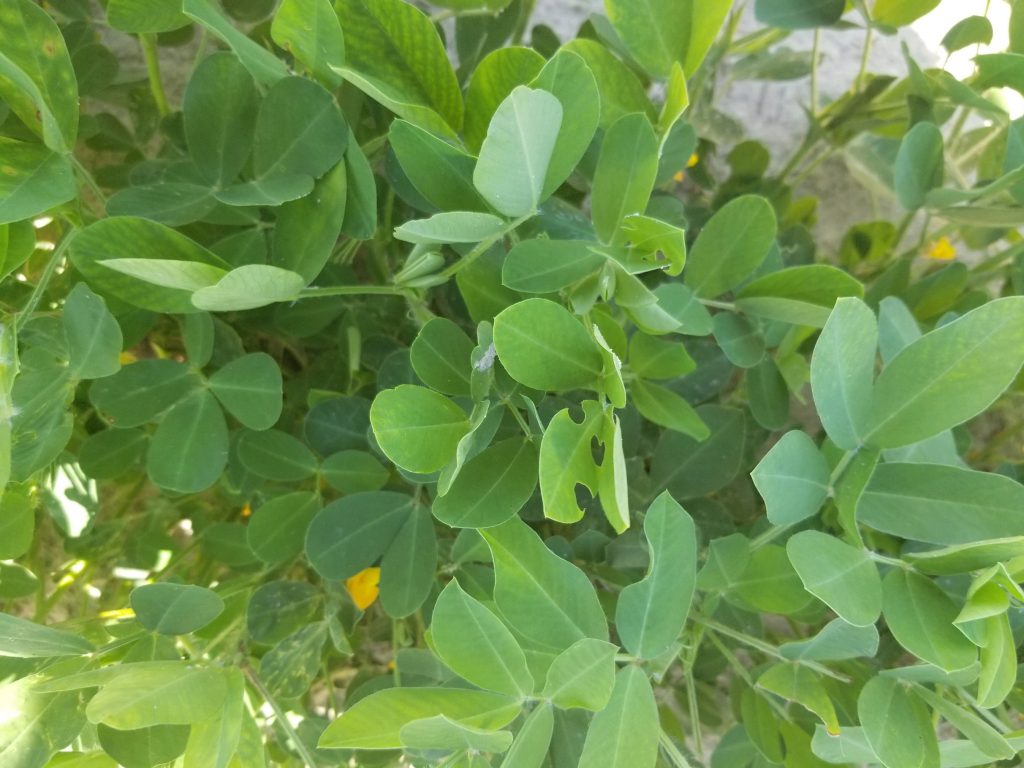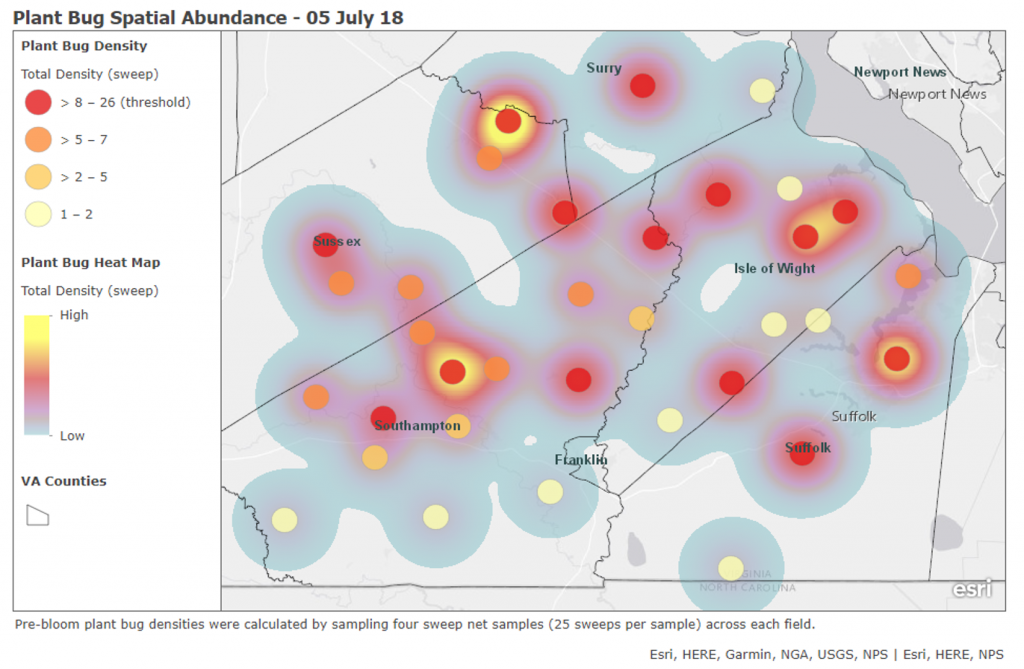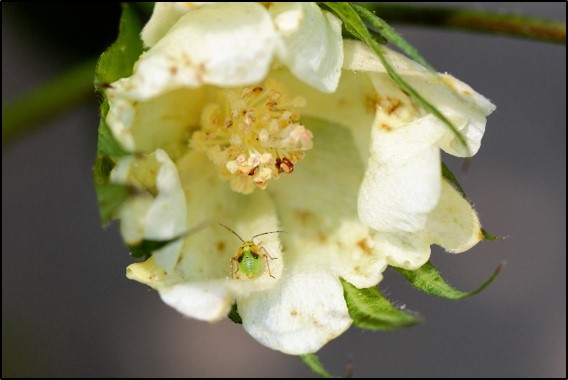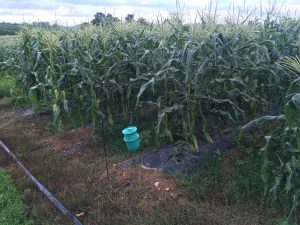Black light trap captures of corn earworm moths in Suffolk really jumped this week, averaging 30 per night (some nights when it wasn’t raining went up to 78). Other locations (Chesapeake, Isle of Wight, Prince George/Templeton, Prince George/Disputanta, Warsaw, and Southampton) averaged only about 1 moth per night this week.
mid-season cotton insect managment
Plant bugs continue to be a problem in some Virginia fields with ¼ of those scouted by the entomology team above threshold for the first two weeks of bloom. In anticipation of the upcoming bollworm flight, Monsanto sponsored a meeting last week at the TAREC to discuss mid-season insect management in cotton. Here is a summary of our discussion:
- For 2 gene cotton (Widestrike, Bollgard II, Twinlink): scouting for eggs is recommended. Sample 100 terminals and leaves. Aim for 10 in 10 locations in the field. If you find 25 eggs, spray an insecticide. I recommend Prevathon unless stink bugs or plant bugs are an issue in your field. In that case, use Besiege. Bollworm (Helicoverpa zea aka corn earworm) and tobacco budworm (Heliothis virescens) eggs are indistinguishable and budworms are 100% controlled by Bt cotton. There is some risk that you are spraying unnecessarily. Very low numbers (<3%) of larvae sampled in non-Bt cotton were budworms in 2016 and 2017.

- For 3 gene cotton (Widestrike 3, Bollgard III, and Twinlink Plus): scouting for 2nd stage larvae (1/8″ or larger) is recommended. This gives in-plant toxins time to kill small worms. Sample 100 bolls, blooms, and/or squares. Aim for 10 in 10 locations per field. If you find three larvae in one trip, two larvae in two consecutive trips (two larvae in each trip), or one larva in three consecutive trips (one larva in each trip), spray insecticides. I do not anticipate damage in 3 gene cotton unless we have very high pressure.
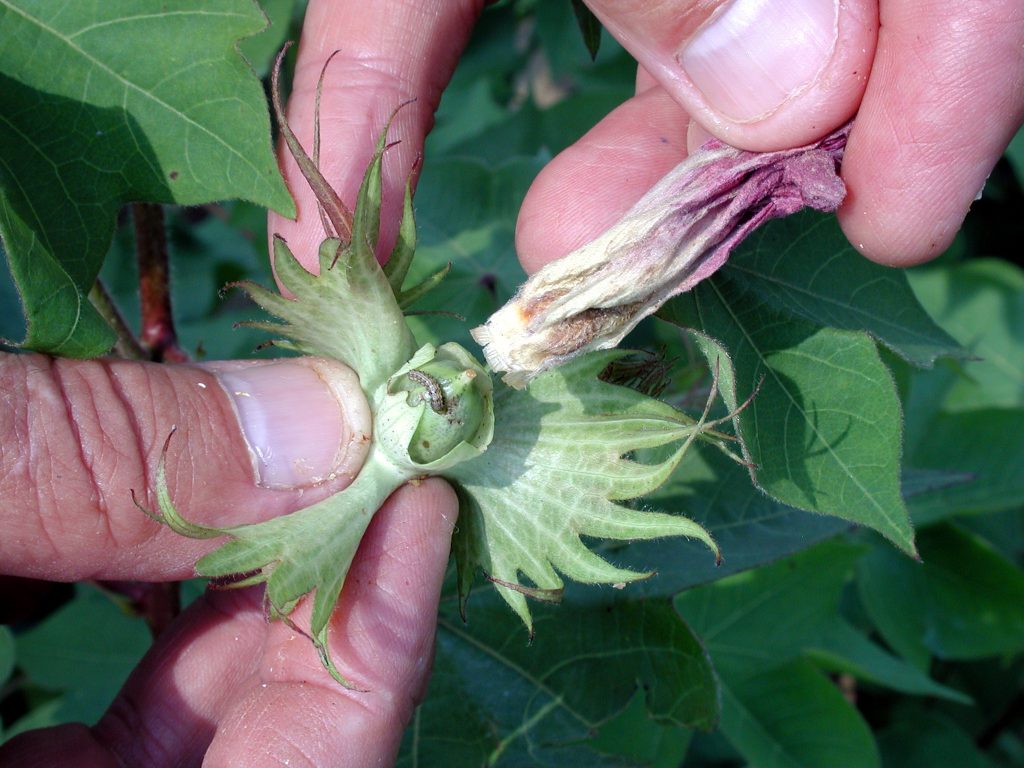
- Pyrethroids have performed poorly in cotton in 2016 and 2017 tests (15-50% control). I think that pyrethroids are too risky in cotton. Some growers are satisfied with the control that they have been achieving. Last year, worm specific products ran out in some Virginia locations. I recommend Steward as an alternative to Prevathon and Besiege for bollworm control in cotton.
- Weekly scouting is recommended for all pests. Bollworm eggs hatch fast (2-3 days) and worms cannot be controlled by any product once they are inside of the boll.
- Spray bugs only at threshold. Bloom threshold for plant bugs is 2-3 per drop cloth sample. For stink bugs, use damaged fruit thresholds: Week of bloom 1 = 50% internal boll damage; week 2 = 30%; weeks 3, 4 and 5 = 10%; week 6 = 20%; week 7 =30%; week 8 = 50%. About a dozen beneficial insects are common in Virginia cotton. Ambush bugs, big-eyed bugs, minute pirate bugs, green lacewings, two species of ladybird beetles, and several types of spiders are examples. They are of two types: 1) predators that prey upon an insect pest (see examples below), or 2) parasites that live within the host insect. These insects, particularly the predators, reduce the number of eggs and larvae of bollworms, plant bug nymphs and aphids. Because these allies lessen the impact of pest insects, common sense dictates that producers use them as a management tool. Their presence often means that growers can delay and, on occasion, eliminate some insecticide applications. However, the rapid increase in pest populations will often overwhelm the beneficial population and applications become necessary. Do not hesitate to spray pest insects at recommended thresholds.
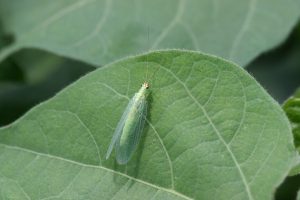

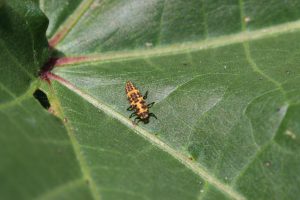

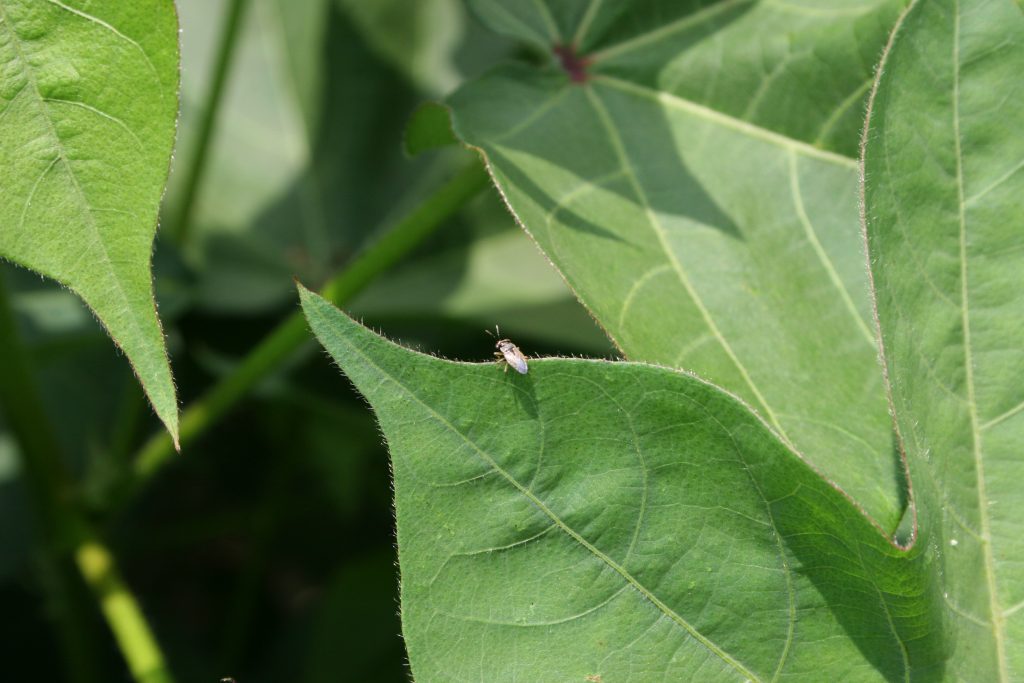
A big thank you to Seth Dorman and his scouting crew and to Glenn Roundtree for initiating and organizing our recent pest management discussion.
Sweet corn IPM Scouting – Week Ending July 20, 2018
Moth trap monitoring
We are monitoring corn earworm and fall armyworm moth activity levels on sweet corn farms in 17 different counties in Virginia. Moth Trap Catch Data are being recorded by: Kuhar Vegetable Entomology lab (Montgomery Co.); Phil Blevins (Washington Co.); Chris Brown (Franklin Co.); Jason Cooper (Rockingham Co.); Ursula Deitch (Northampton Co.); Helene Doughty (Accomack Co.); Roy Flanagan (VA Beach); Bob Jones (Charlotte Co.); Kenner Love (Page and Rappahannock Co.); Laura Maxey Nay (Hanover Co.); Steve Pottorff (Carrol Co.); Stephanie Romelczyk (Westmoreland Co.); Beth Sastre-Flores (Loudoun Co.); Laura Siegle (Amelia Co.); Rebekah Slabach (Halifax Co.); and Mark Sutphin (Frederick Co.). Data are posted weekly.
Trap Catch
Below are some trap catch results (moths per night) for some of the locations around Virginia for this week. In summary, we are observing a slight drop off in corn earworm moth activity at most locations, except Amelia County, which posted the highest corn earworm activity this week. Very little fall armyworm activity has been observed at this point, and numbers are so low that they are not presented.
Corn earworm black light trap report for July 19, 2018
Corn earworm moth captures in Virginia black light traps ranged from zero to 2 per night this week. Watson Lawrence in Chesapeake averaged 1 moth per night; LIvvy Preisser in Isle of Wight had 0.6 per night; Scott Reiter reported zero in Prince George (Templeton) and 0.5 per night in Disputanta. Mary Beahm in Warsaw saw 0.1 corn earworm moths per night; and in Suffolk we caught an average of 2.1 per night. We look forward to Dwayne Sanders’ help with operating a trap in Waverly!
In 2017, black light trap captures of corn earworm moths started to spike in the third week of July. Please check back for next week’s report!
Sweetcorn IPM Scouting in Virginia – Week ending July 13, 2018
We are monitoring corn earworm and fall armyworm moth activity levels on sweet corn farms in 17 different counties in Virginia. Moth Trap Catch Data are being recorded by: Kuhar Vegetable Entomology lab (Montgomery Co.); Phil Blevins (Washington Co.); Chris Brown (Franklin Co.); Jason Cooper (Rockingham Co.); Ursula Deitch (Northampton Co.); Helene Doughty (Accomack Co.); Roy Flanagan (VA Beach); Bob Jones (Charlotte Co.); Kenner Love (Page and Rappahannock Co.); Laura Maxey Nay (Hanover Co.); Steve Pottorff (Carrol Co.); Stephanie Romelczyk (Westmoreland Co.); Beth Sastre-Flores (Loudoun Co.); Laura Siegle (Amelia Co.); Rebekah Slabach (Halifax Co.); and Mark Sutphin (Frederick Co.). Data are posted weekly.
Below are some trap catch results (moths per night) for some of the locations around Virginia for this week (note we do not have data for all locations yet). In summary, we are observing the highest corn earworm activity in the eastern portion of the state including Virginia Beach and Exmore on the Eastern Shore. Pest pressure is considered high in those locations. Above threshold trap catch of corn earworm is also being observed on some farms in the southwest region of the state (Franklin County and Montgomery County). Very little fall armyworm activity has been observed at this point.
Region County Field CEW/night FAW/night
Eastern Accomack Painter
Eastern Accomack Painter
Eastern Virginia Beach Northridge 3.4 2.9
Eastern Virginia Beach Pungo 4.3 0
Eastern Virginia Beach Creeds 5.9 0.1
Eastern Northampton Capeville 1.0 0
Eastern Northampton Cheriton 1.9 0
Eastern Northampton Eastville 0.7 0
Eastern Northampton Exmore 7.4 0
Eastern Westmoreland Field 0.2 0
Central Amelia Field
Central Hanover Wiblin
Central Hanover Haynes
Central Halifax
Central Halifax
Central Charlotte
Northern Loudoun Field1 1.0 0
Northern Loudoun Field2 <.2 0
Northern Loudoun Field3 <.2 0
Northern Rappahannock
Northern Page
Northern Frederick Field1 0.3 0
Northern Frederick Field2 0 0
Northern Rockingham
Southwest Montgomery Whitethorne 0.0 0
Southwest Montgomery Homefield 0.0 0
Southwest Montgomery Wall 2.0 0
Southwest Franklin Wirtz 1.4 0
Southwest Carroll
Southwest Washington Abingdon
Corn earworm report for July 12, 2018
Corn earworm moth numbers have been low in local black light traps. Watson Lawrence reported 1.4 per night in Chesapeake; Livvy Preisser averaged 0.6 per night in Isle of Wight; Mary Beahm had zero in Warsaw; we had 0.9 per night in Suffolk this week.
Virginia Cooperative Extension Agents and Virginia Tech employees will be scouting field corn for corn earworm larvae this month as part of Dr. Taylor’s annual survey. They examine ears in five corn fields per county and calculate the average percent infested ears. Corn is a nursery crop for corn earworm–the percent of infested ears can be a useful indicator of the pressure to expect in other crops such as soybean, cotton, peanut, etc. when moths emerge and migrate out of corn. We’ll provide results of the survey in the first week of August.
We have tested 80 corn earworm moths in our cypermethrin vial tests this season, with only 8% surviving the 24-hour exposure to 5 micrograms/vial of cypermethrin. It would be great to see moth survival remain that low, but we need to continue testing to see what happens when we get the flight out of corn and later into the season.
Corn earworm found in Virginia peanut fields
Peanut scouts in Suffolk today found fields with above threshold numbers of corn earworm/tobacco budworm (4 per row foot). Fields previously treated recently with chlorpyrifos may be at higher risk because they have fewer beneficial predators.
Black beat cloths can aide in sampling. However, shaking and slapping plants will dislodge worms onto soil for easy counting. Make sure and check around the base of the plant when using either method.
Feeding damage shows up in the form of holes in foliage. Worms may also feed on terminals and flowers so scouting for damage alone is not recommended. Peanuts can lose a lot of leaf material without losing yield, but drought-stressed or herbicide injured plants are at higher risk for yield-loss. Do not spray unless necessary. Recent dry weather in combination with broad-spectrum insecticides can flair spider mites.
Pyrethoids are a common choice for earworm control in Virginia and most products can be tank mixed with a fungicide to save money. Always read and follow label instructions. Pyrethroids are losing efficacy against earworm and we have experienced spray failures in other crops (soybean, cotton, sweet corn). Budworm have been resistant to pyrethroids for some time. You will not be able to distinguish these two species in the field. Refer to NCSU video for details. Do not expect complete control of large worms or high populations. Alternative products labeled in peanut include Prevathon, Besiege, Steward, Radiant, Intrepid Edge, and Blackhawk. A list of products and rates is included in Virginia Tech’s Pest Management Guide.
Plant bug control in blooming cotton
Tarnished plant bugs continue to be a problem in some Virginia cotton fields. This week, scouts found 14 of 32 fields over the pre-bloom threshold (8 per 100 sweeps) and increasing numbers of nymphs. Drop cloth sampling is recommended for blooming cotton and counting squares is no longer a good indication of feeding. Threshold is 2-3 bugs per sample. Check out this short video (https://www.youtube.com/watch?v=XRnZhLczZJ0) if you have questions on how to use this method or are unsure of what nymphs look like. Dirty blooms indicate feeding, but active populations should be confirmed before a spray is made.
As cotton begins to bloom, neonicotinoids (e.g., Admire Pro, Centric, Belay) lose efficacy and I recommend rotating to a pyrethroid, a pyrethroid/acephate mix, or Bidrin. These products will also control stink bugs if present. Transform is not labeled in Virginia, but our representative in Richmond is working hard to get us a Section 18 and I hope to have one in place by next year at the latest. All of these products will kill beneficial predators in your field. This is a concern as we near bollworm egg lay in cotton.
I encourage you to treat for insect pests only when thresholds are reached. Plant bug control will likely be needed through mid-August when populations peak, even in fields that have been previously sprayed. Spider mites, aphids, and bollworm (in two-gene cotton) risk increases with each broad-spectrum insecticide use, as does the risk for sprayer fatigue.
Special thanks to graduate student Seth Dorman and crew for their continued scouting efforts.
Sweet Corn IPM Scouting in VA Kicks Off
Corn earworm (Fig. 1) and fall armyworm are two important pests of a number of agricultural crops in Virginia. Sweet corn, in particular, is extremely vulnerable to attack by the larvae (or caterpillars) of these moth pests. Monitoring moth catch in pheromone-baited traps can help IPM decision-making. Corn earworm is monitored using Heliothis traps (Fig 2). Pheromone lures are changed once per month and traps are monitored every few days. In general trap catch less than 1 per night means relatively low pest pressure and sprays can probably be spaced 5-6 days apart during silking. However, a catch of >1 or >13 moths per night means moderate and high pest pressure, respectively, and a more frequent spray interval is justified.
For fall armyworm, pheromone-baited bucket traps (Fig 3) are used to alert growers to the arrival of this late summer migrant from the South and its relative pest pressure.
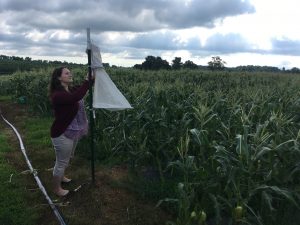
Fig. 2. Heliothis trap being checked by summer intern Cailin Orgen for CEW moths in Frederick County, VA.
In 2018, with the help from 14 VCE agents, we are monitoring these pests on sweet corn farms in 17 different counties in Virginia. Moth Trap Catch Data are being recorded by: Kuhar Vegetable Entomology lab (Montgomery Co.); Phil Blevins (Washington Co.); Chris Brown (Franklin Co.); Jason Cooper (Rockingham Co.); Ursula Deitch (Northampton Co.); Helene Doughty (Accomack Co.); Roy Flanagan (VA Beach); Bob Jones (Charlotte Co.); Kenner Love (Page and Rappahannock Co.); Laura Maxey Nay (Hanover Co.); Steve Pottorff (Carrol Co.); Stephanie Romelczyk (Westmoreland Co.); Beth Sastre-Flores (Loudoun Co.); Laura Siegle (Amelia Co.); Rebekah Slabach (Halifax Co.); and Mark Sutphin (Frederick Co.). Data will be posted weekly.
Here are some trap catch results (moths per night) for some of the locations around Virginia for this week (note we do not have data for all locations yet):
Region County Field CEW/night FAW/night
Eastern Accomack Painter
Eastern Accomack Painter
Eastern Virginia Beach Cromwell 5.0 NA
Eastern Virginia Beach Henley 4.0 0
Eastern Virginia Beach Vaughan 1.0 0.2
Eastern Northampton Capeville 1.8 0
Eastern Northampton Cheriton 3.0 0
Eastern Northampton Eastville 1.1 0
Eastern Northampton Exmore 12.9 0
Eastern Westmoreland Field
Central Amelia Field
Central Hanover Wiblin
Central Hanover Haynes
Central Halifax
Central Halifax
Central Charlotte
Northern Loudoun
Northern Loudoun
Northern Rappahannock
Northern Page
Northern Frederick West Oaks
Northern Frederick Woodbine
Northern Rockingham
Southwest Montgomery Whitethorne 0.0 0
Southwest Montgomery Homefield Farm 1.0 0
Southwest Montgomery Wall 20.0 0
Southwest Franklin Wirtz
Southwest Carroll
Southwest Washington Abingdon
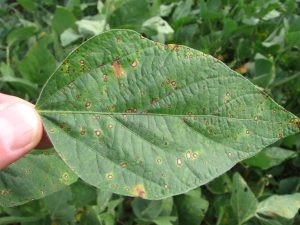
Walk Your Fields
For greater soybean yields, one of the best things that you can do is walk your fields. Many problems reveal themselves during the summer. Actions taken or not taken can be very noticeable. By walking fields, we can see what’s working and what’s not working. Certain problems can be solved, some cannot. For those that cannot be solved this year, we can do better next season by understanding why we have the problem. Therefore, a review of how to diagnose your crop will likely beneficial.
A few years ago, I published “Troubleshooting The Soybean Crop“. Although a little dated, most of the information is still good. This publication will guide you through how to go about diagnosing problems, includes a vegetative- and reproductive-stage outline with lots of photos, and also includes a sample crop scouting and diagnostic form. You can download a view a PDF copy, or contact me – I still have a few hard copies left. By following some general guidelines, one can become quite good at diagnosing problems. Below is a summary.
First, document everything! Memories tend to fade. We often forget or overlook details. You can document by taken notes (many phone apps or iPad/tablets work well for this). Make a recording. Take pictures – this is especially useful when you need help – and send those photos to others.
PRELIMINARY FACT FINDING. You can obtain plenty of information before you even get to the field. Although I call this preliminary (as if you’ve not seen the problem), you may need to go back to the office to refresh your memory of what you did. Information that can be acquired beforehand or back in the office includes: 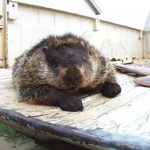
- Cropping History
- Equipment
- Soil Information
- Weather
- Pest Management Information
- Tillage and Other Cultural Practices
THE FIELD VISIT
- Take all materials and equipment needed (e.g., phones, paper, shovel, plastic bags, soil probes, etc.)
- Windshield/Whole Field Investigation
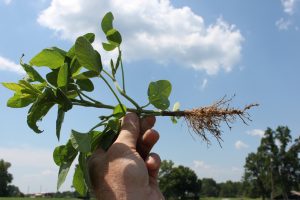
- Above-Ground Inspection
- Take Appropriate Plant or Soil Samples
- Equipment Check
- Interaction with Others
- Document Everything!
ANALYSIS OF DATA AND FINDINGS
- Patterns
- Look-Alike Symptoms
- Interacting Factors/More Than One Problem
DRAWING A CONCLUSION. Review the facts and data. Eliminate unlikely causes. Validate likely causes. You may be able to drawn a conclusion in the field, but lab analysis may be needed.
FOLLOW UP. Revisit the field. If you took corrective action, did it work? Why or why not?
This is a very rough outline of the guide. Again, if you want a hard copy of Troubleshooting The Soybean Crop, contact me.


